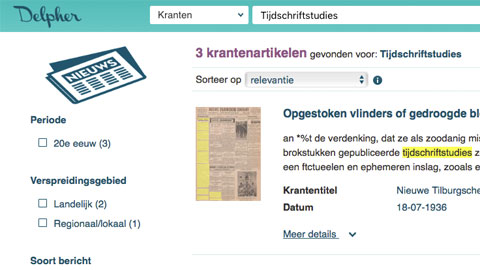Possibilities and problems with Delpher – a symposium report
On the 7th of December, the National Library of the Netherlands in The Hague (Koninklijke Bibliotheek or KB) hosted a symposium on the digital archive Delpher and its uses in historical research. Delpher is one of the most important Dutch digital archives for newspapers and periodicals, developed by the KB in partnership with various national and international academic institutions, libraries and heritage institutes. Delpher can be accessed by anyone with an internet connection, without costs or subscription.
Hosted by TS > Journal for the Study of Periodical Media, in partnership with the KB, the Huizinga Institute for Cultural History, and the OSL Graduate School for Literary Studies, the symposium was also occasion for TS to present its recent issue 38, in which Delpher takes center stage. The aim of both the symposium and the journal is to ‘offer several new perspectives upon methodological debates in academic circles regarding the “digital humanities”, concerning the digital humanities generally and also focusing on particular digital archives of newspapers and/or journals’. Keynote lectures were delivered by professor Huub Wijfjes from the Universities of Groningen and Amsterdam, and professor Michiel van Groesen from the University of Leiden.

Questioning Delpher
The symposium opened with a short introduction by Thomas Smits, editor in Chief of TS. He emphasised the richness of Delpher as an historical source, but stressed that Delpher as a digital archive is as much a construct as the more familiar ‘physical’ archives. As such, researchers should not shy away from questioning Delpher on a fundamental as well as a substantial level. Professor Wijfjes was critical on a more fundamental level. He argued that the increase in digitised historical sources offers researchers a ‘beckoning perspective’, in which answers to historical questions seem within easier reach. But Wijfjes justly expounded on this claim, by noticing that this beckoning perspective may also lead historians astray. While Delpher is a rich source of digitised printed materials, it only represents a fraction of what is available. Wijfjes also offered an – admittedly artificial – contrast between those who are sceptical about the uses of digital sources such as Delpher, and those who believe in its use and application in research – and seemed to place himself in the former category.
This contrast between believers and sceptics is an interesting one, since the speakers that followed Wijfjes all seem to fall within the latter category. Hermione Giffard and Maarten van den Bos (both of the University of Utrecht) questioned the arrangement of Delpher’s search results, while Jesper Verhoef (University of Utrecht) spoke about the value and problems related to digitised advertisements, historical newspapers and the portable radio.
Gatekeeper?
The second keynote lecturer, Professor Van Groesen, discussed the earliest available newspapers in Delpher. More importantly, he argued that Delpher should take its role as a ‘gatekeeper’ of digital data (more) seriously. Information about the quantity and quality of the sources needs to be less opaque. That would provide users with more insight into both the benefits and limitations of working with Delpher.
In her closing statement, Maaike Napolitano (product manager of Delpher at the KB) offered a more positive note in contrast to the preceding speakers, who focused on critizing Delpher and pointing out how to imrove it. She pointed out a range of research options that are already available through Delpher in its current form. Both the KB and Delpher face financial, legal and technical restrictions limitations. And if we tone down our expectations of Delpher as a historical source just a little for the moment, we may not become divided into opposing groups of either sceptics or believers.
Trude Dijkstra



